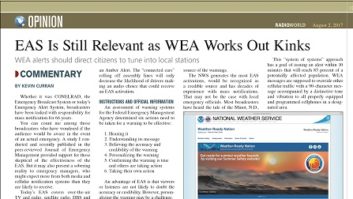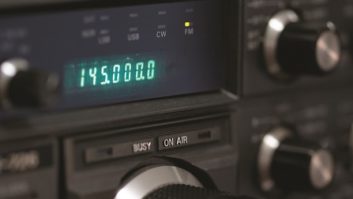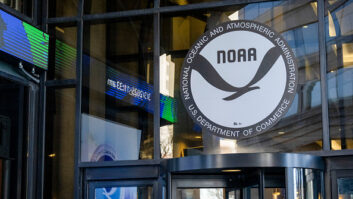Whether it was CONELRAD, the Emergency Broadcast System or today’s Emergency Alert System, broadcasters have been tasked with responsibility for mass notification for 66 years.
You can count me among those broadcasters who have wondered if the audience would be aware in the event of an actual emergency. A study I conducted and recently published in the peer-reviewed Journal of Emergency Management provided support for those skeptical of the effectiveness of the EAS. But it may also present a sobering reality to emergency managers, who might expect more from both media and cellular notification systems than they are likely to receive.

Today’s EAS covers over-the-air TV and radio, satellite radio, DBS and cable systems. As the number of media options has increased, the chance of an EAS message reaching a critical mass of its intended audience has decreased.
Veteran engineer James O’Neal wrote in TV Technology in 2014, “It’s not the same world that existed a few decades ago.”
Time-shifted television viewing has been around since the advent of the VCR. One study of cable subscribers found 45 percent were using DVRs to time-shift viewing, 8 percent of those waiting eight to 15 days to view the recorded shows, long after the useful life of a severe thunderstorm warning. With Hulu and similar video on demand services available, there is no way for broadcasters to reach those viewers with timely alerts.
The view is not much better on the radio side, where one survey found more than a quarter of drivers were listening to internet audio streams through a smartphone connected to the vehicle’s audio system. That self-curated Pandora playlist is not going to be interrupted by an Amber Alert. The “connected cars” rolling off assembly lines will only decrease the likelihood of drivers making an audio choice that could receive an EAS activation.
INSTRUCTIONS AND OFFICIAL INFORMATION
An assessment of warning systems for the Federal Emergency Management Agency determined six actions need to be taken for a warning to be effective:
1. Hearing it
2. Understanding its message
3. Believing the accuracy and credibility of the warning
4. Personalizing the warning
5. Confirming the warning is true and others are taking action
6. Taking their own action
An advantage of EAS is that viewers or listeners are not likely to doubt the accuracy or credibility. However, personalizing the warning may be a challenge.
“One of the drawbacks of the current EAS system is that it tends to send warning messages to a much larger area than is actually at risk from the hazard,” according to Mike Smith, a warning coordination meteorologist at the National Weather Service storm prediction center in Norman, Okla.
TV stations in markets such as Wichita-Hutchinson, Kan., are tasked with providing service over large territories, perhaps of more than one state. An EAS alert on a tornado warning would reach not only those potentially affected, but others far from the warning area.

Another challenge for EAS is the source of the warnings.
The NWS generates the most EAS activations, would be recognized as a credible source and has decades of experience with mass notifications. That may not be the case with local emergency officials. Most broadcasters have heard the tale of the Minot, N.D., train wreck and the lack of an EAS alert that a toxic cloud was spreading through part of the city. Many reports blamed the absence of an alert on the unattended operation of the local radio stations because police officials said they could not reach anyone in the studio. A post-event investigation found that officers were calling an EBS phone line that had been disconnected when the stations gave the dispatch center an EAS encoder. That encoder had never been installed.
THE CELLULAR OPTION
In 2013, Warren Schulz, a veteran Chicago engineer and former Illinois EAS chair, suggested in Radio World, “EAS cannot be fixed and should be closed down. Rely on cellphone text alerts. If desired, reserve the EAS radio daisy chain for long-form messages.”
FEMA and the FCC sought to address some of these concerns with the Integrated Public Alert and Warning System. It includes the EAS and what is now called Wireless Emergency Alerts (formerly known as the Commercial Mobile Alert System and the Personal Localized Alerting Network).
This “system of systems” approach has a goal of issuing an alert within 10 minutes that will reach 85 percent of a potentially affected population. WEA messages are supposed to override other cellular traffic with a 90-character message accompanied by a distinctive tone and vibration to all properly equipped and programmed cellphones in a designated area.
This is a development welcomed by Morgan Hoaglin at the Arizona Department of Emergency Management, who noted, “IPAWS does not depend on any one technology.”
With cellphones in just about everyone’s pocket, it would seem that WEA could replace the other mass notification systems. An update to that old saying may go, “You can lead a person to information that could save their life, but you can’t make them receive it.”
Immediately after one of the first WEA messages in Phoenix, my Twitter stream was full of users asking what had just happened to their phones — and how to prevent it from happening again. Later tweets explained how the settings could be adjusted to turn off two of the three alert categories (national alerts cannot be disabled).
A 2013 study of post-alert Twitter comments for FEMA’s parent agency, the Department of Homeland Security, showed this user reaction was not unusual. The DHS consultants admit their anecdotal evidence points to a need for further study of message content, geo-targeting and both understanding and improving the response to the warnings by phone users. The report mentioned support from government websites, but little mention of the system from carriers or retailers.
On Sept. 9, 2016, the FCC issued report & order as well as a further NPRM FCC 16-127. The R&O required alert messages to expand from a maximum 90 characters to a maximum of 360 characters on 4G-LTE and future networks. It added a “Public Safety Messages” category, required cell carriers to allow embedding phone numbers and/or URLs placed in WEA messages and support WEA messages in Spanish. The carriers must also maintain a log of the messages, narrow geo-targeting as possible, and send the messages without delay. The R&O concluded with enhanced provisions for testing, exercising, and raising awareness of the WEA system.
The Further NPRM included a study of ways to keep WEA consistent with advancing technology, such as multimedia, multilingual and geo-targeting possibilities.
WHERE DOES EAS FIT IN?
Even if the expectation of EAS as a first alert source is overestimated, it is still the best option for continuing information. A WEA message cannot convey information about evacuation routes or shelter locations; the information Schulz wrote about would be a proper continuing use for the EAS. Radio stations manage to find ways to stay on the air in the direst circumstances.
Broadcasters should be pushing for a procedure where a WEA message refers to local stations by frequency so users would know where to tune for official information. With the 90-character limit, an alert may only be able to say, “Check local media.” Directing people to the proper local media could prove to be a lifesaver.
The author is a Ph.D. student at the University of Oklahoma’s Gaylord College of Journalism and Mass Communication. He has held a variety of radio and television news and management positions in New York, Washington, Los Angeles and Phoenix. Reach him at [email protected].
Comment on this or any story to [email protected] with “Letter to the Editor” in the subject field.







